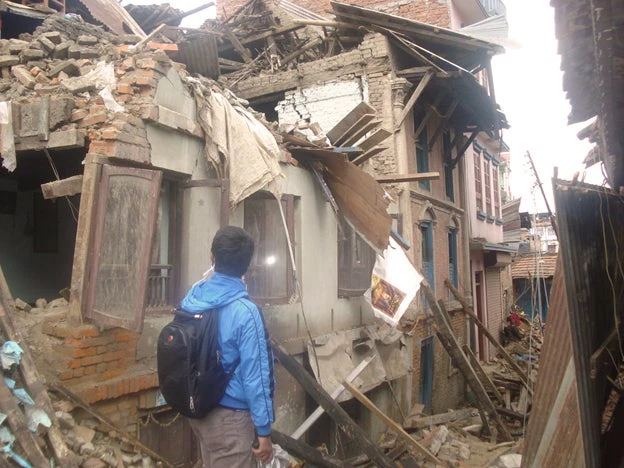
It has been one week since a devastating 7.8 magnitude earthquake struck Nepal, its epicenter 75 km northwest of Kathmandu, and the toll is only beginning to be counted.
As the number of dead rose, to more than 6,000 today, early reports of the destruction inevitably focused on search-and-rescue efforts in the easily-accessible Kathmandu valley, the deadly avalanche at Everest’s base camp, and the collapse of many of the historic Hindu temples in the palace squares of Kathmandu, Patan and Bhaktapur.
Stunned by the original quake and the long line of aftershocks—some as large as 6.5 or 6.8 in magnitude—most Nepalis in the first days focused on their immediate needs: connecting with their families, mourning the dead, getting medical treatment for the injured, setting up camp outside of their homes, and laying aside key supplies for the coming days and weeks.
Overnight the Kathmandu valley was interspersed with IDP (Internally Displaced Persons) camps, as people pitched tents and built tarpaulin lean-tos in their yards, in public parks, on traffic roundabouts, on sidewalks and plazas, and even on the streets--too frightened to return to their homes as the aftershocks continue to rumble through. For a week they have hunkered down on a bit of grass or pavement, under tarps and blankets, in cold rainy nights made darker by the loss of electricity. For many, it was misery.
Within hours of the quake, at the World Bank office in Kathmandu, essential staff like Bigyan Pradhan (acting Country Manager), Prakash Chapagain (Resource Management Specialist) and Pradeep Shah (Security Specialist) began contacting all staff to ensure that they were alright and to ascertain their needs; to acquire tents, plastic sheets, blankets, medicines and other survival equipment to distribute to those in need; and to initiate Bank Group work in response to the disaster. Many worked despite their own challenging personal circumstances. Neighboring offices—in Delhi and Dhaka—sent relief supplies in record time, by road and by air.
Staff and dependents were accounted for within hours, and within days we also knew that the homes of some members of the World Bank family had been destroyed. Alina Thapa will not be able to return home and Kesh Shrestha lost the upper storey of his house. Two contract drivers had their homes reduced to rubble.
Fortunately, no one in the World Bank family was injured or killed—though another contract driver lost his brother and the brother’s family when their house collapsed.
Despite the tragic loss of life, many Nepalis noted that it was good luck that the earthquake hit in a late Saturday morning, when schools and offices were closed and most people were awake and outside of the house. Twelve or 24 hours earlier or later, and the death toll would have been much higher.
It was good luck that kept open the airport and the two or three roads into the Kathmandu valley. Supplies were still able to reach the needy. Nepal’s internal migrants—the youths and husbands who work in the valley—were able to travel out to check on their families in the rural areas. Water still flowed in the pipes and the irrigation canals. Telephone networks were spotty, but largely functional, and power was gradually restored to many neighborhoods. Within a few days, too, many groceries, butcheries and bakeries were again open in the valley, and for the luckier—and richer—residents of the valley, life could plausibly be said to be returning to normal.
Or so it appeared. How wrong that assessment was. Scarcely 100 km away, life was immensely different.
[Part 2 of this story 'Nepal earthquake emergency barely begun in rural areas' will be published tomorrow Sunday, May 3]


Join the Conversation